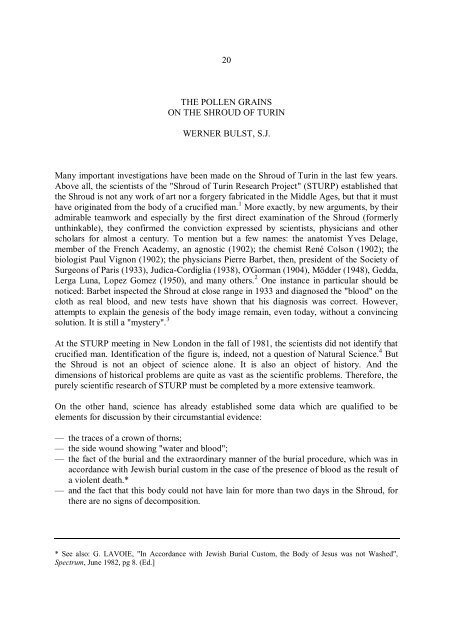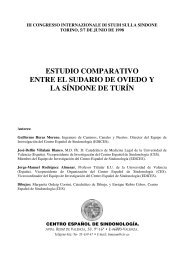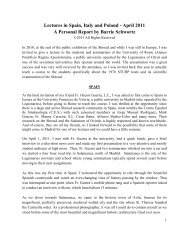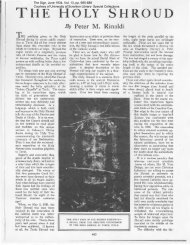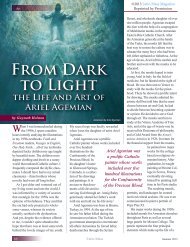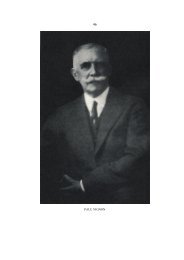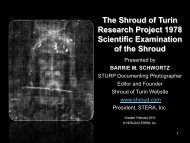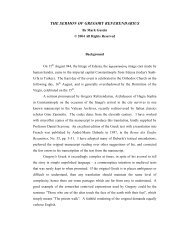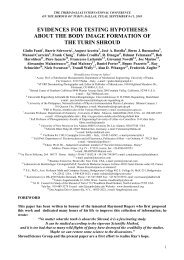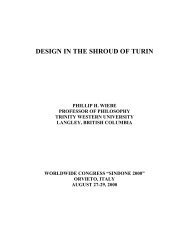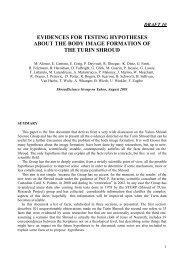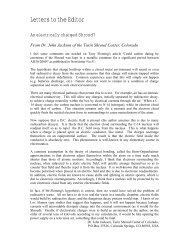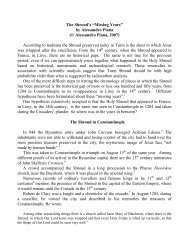Create successful ePaper yourself
Turn your PDF publications into a flip-book with our unique Google optimized e-Paper software.
21a
22a<str<strong>on</strong>g>The</str<strong>on</strong>g> places where pollens have been found by Dr. Frei...[<strong>Shroud</strong>.com Editor’s Note: This was a 3 page foldout in <strong>the</strong> original printed journal]
24an accurate examinati<strong>on</strong>, because many <strong>of</strong> <strong>the</strong> pollens are not yet registered withmicrophotographs in <strong>the</strong> botanic manuals. I learned from <strong>the</strong> botanists that <strong>the</strong> identificati<strong>on</strong><strong>of</strong> pollens is very difficult work. In some cases, perhaps, not <strong>the</strong> species (as in Dr. Frei's lists)but <strong>on</strong>ly <strong>the</strong> genus, i.e., <strong>the</strong> larger category in <strong>the</strong> botanic system, can be defined.Dr. Frei was an excepti<strong>on</strong>al expert in Mediterranean flora. He had made his doctoral <strong>the</strong>sis <strong>on</strong><strong>the</strong> flora <strong>of</strong> Sicily. For more than forty years, he spent his vacati<strong>on</strong>s botanizing in Sou<strong>the</strong>rnFrance and Sou<strong>the</strong>rn Italy, in Corsica, Tunisia, etc., and <strong>the</strong> last ten years in <strong>the</strong> Middle East,especially Palestine. He had built up a Mediterranean herbarium. And he explored <strong>the</strong> florawith <strong>the</strong> eyes <strong>of</strong> a criminologist. I suggest that no <strong>on</strong>e could match his extensive knowledge<strong>of</strong> pollens from Mediterranean plants. He identified all <strong>the</strong> pollens he had detected <strong>on</strong> <strong>the</strong><strong>Shroud</strong> by comparing <strong>the</strong>m with ripe pollens which he himself had ga<strong>the</strong>red from plants in<strong>the</strong> regi<strong>on</strong>s <strong>of</strong> <strong>the</strong> Middle East. <str<strong>on</strong>g>The</str<strong>on</strong>g>refore,I am c<strong>on</strong>vinced that at least <strong>the</strong> general view presented in <strong>the</strong> following table is a solid basisthat will not be depreciated even though some completi<strong>on</strong>s, correcti<strong>on</strong>s or queries shouldeventually be made. My own c<strong>on</strong>tributi<strong>on</strong> is <strong>the</strong> new manner <strong>of</strong> presentati<strong>on</strong> (in principleapproved by Dr. Frei himself) and some historical and geographical aspects.Statistics and Analysis1) <str<strong>on</strong>g>Pollen</str<strong>on</strong>g>s from 58 species <strong>of</strong> plants have been found <strong>on</strong> <strong>the</strong> <strong>Shroud</strong>. But <strong>on</strong>ly 17 <strong>of</strong> <strong>the</strong>se,i.e., less than <strong>on</strong>e-third, grow in France or Italy. It was to be expected that pollen fromEuropean plants would be found <strong>on</strong> <strong>the</strong> <strong>Shroud</strong>. But in view <strong>of</strong> <strong>the</strong> immense variety <strong>of</strong>European vegetati<strong>on</strong>, <strong>the</strong> small representati<strong>on</strong> <strong>of</strong> European species is ast<strong>on</strong>ishing. And all 17except <strong>on</strong>e (#4) were detected <strong>on</strong> <strong>the</strong> first twelve samples taken by Dr. Frei in 1973. From hissamples taken in October 1978 and those he received from Pr<strong>of</strong>s. Baima Boll<strong>on</strong>e and Riggi,he identified ten fur<strong>the</strong>r species, but <strong>on</strong>ly <strong>on</strong>e (#4) from a European plant. 5 <str<strong>on</strong>g>The</str<strong>on</strong>g> small number<strong>of</strong> European species can be explained by <strong>the</strong> history <strong>of</strong> <strong>the</strong> <strong>Shroud</strong> in Europe, for, normallykept in a closed reliquary, <strong>the</strong> <strong>Shroud</strong> was protected from pollen c<strong>on</strong>taminati<strong>on</strong>. Only <strong>on</strong>special occasi<strong>on</strong>s was it exposed in <strong>the</strong> open.Perhaps <strong>the</strong> following is a good illustrati<strong>on</strong>: <str<strong>on</strong>g>The</str<strong>on</strong>g>re are rice pollens <strong>on</strong> <strong>the</strong> <strong>Shroud</strong>; in 1494 and1560, <strong>the</strong> relic was exposed <strong>on</strong> <strong>the</strong> balc<strong>on</strong>y <strong>of</strong> <strong>the</strong> Castle <strong>of</strong> Vercelli, 6 Europe's principle ricegrowingcenter.2) <str<strong>on</strong>g>The</str<strong>on</strong>g> spectrum <strong>of</strong> n<strong>on</strong>-European species is highly ast<strong>on</strong>ishing. It is true that some <strong>of</strong> <strong>the</strong>seplants grow in many regi<strong>on</strong>s <strong>of</strong> Africa and Western Asia, but <strong>on</strong>ly some <strong>of</strong> <strong>the</strong>m. <str<strong>on</strong>g>The</str<strong>on</strong>g>re is<strong>on</strong>ly <strong>on</strong>e place where all <strong>the</strong>se plants—with <strong>the</strong> excepti<strong>on</strong> <strong>of</strong> three, which need specialc<strong>on</strong>siderati<strong>on</strong>—grow in a very small radius: Jerusalem. Such an excepti<strong>on</strong>ally wide spectrum<strong>of</strong> vegetati<strong>on</strong> in such a small area is determined by <strong>the</strong> extraordinary geographical positi<strong>on</strong> <strong>of</strong>Jerusalem: <strong>on</strong> <strong>the</strong> mountain ridge <strong>of</strong> Juda, between <strong>the</strong> Mediterranean area and <strong>the</strong> steppesand deserts around <strong>the</strong> Dead Sea, all with very different soils, as <strong>on</strong>e can see <strong>on</strong> <strong>the</strong> map <strong>of</strong>Palestine (Fig. 1).Certainly, some pollens could have been deposited <strong>on</strong> <strong>the</strong> <strong>Shroud</strong> by accident. During <strong>the</strong>tests <strong>of</strong> October 1978, such an accident occurred. When Dr. Frei was ready to take samplesby sticky tapes, <strong>on</strong>e
25<strong>of</strong> <strong>the</strong> STURP scientists, fearing c<strong>on</strong>taminati<strong>on</strong> <strong>of</strong> <strong>the</strong> Linen, helpfully gave him a pair <strong>of</strong>cott<strong>on</strong> gloves brought from America for <strong>the</strong> express purpose <strong>of</strong> handling <strong>the</strong> <strong>Shroud</strong>. And soa pollen grain from an American plant (Ambrosia cor<strong>on</strong>opifolia) was picked up <strong>on</strong> <strong>the</strong> tape.Dr. Frei registered it, but it is obviously without any significance in <strong>the</strong> history <strong>of</strong> <strong>the</strong> <strong>Shroud</strong>.Even though some pollens could have been deposited <strong>on</strong> <strong>the</strong> <strong>Shroud</strong> by accident, <strong>the</strong>clearness <strong>of</strong> <strong>the</strong> overall view is striking: all n<strong>on</strong>-European plants whose pollens are <strong>on</strong> <strong>the</strong><strong>Shroud</strong>, except <strong>the</strong> three menti<strong>on</strong>ed above, grow in Jerusalem. And <strong>the</strong> number <strong>of</strong> <strong>the</strong>sespecies far outnumbers those <strong>of</strong> European species. This cannot be an accident. <str<strong>on</strong>g>The</str<strong>on</strong>g> <strong>on</strong>lylogical explanati<strong>on</strong> for such an abundance <strong>of</strong> pollens from plants which grow in Jerusalemseems to be that <strong>the</strong> <strong>Shroud</strong> was <strong>the</strong>re before it came to Europe.An Objecti<strong>on</strong>Against this argument, an apparently weighty objecti<strong>on</strong> has been raised: <str<strong>on</strong>g>The</str<strong>on</strong>g> pollens couldhave been carried to Europe <strong>on</strong> winds. Indeed, under certain c<strong>on</strong>diti<strong>on</strong>s, pollen can betransported over hundreds <strong>of</strong> kilometers, e.g., from Florida to New York. However, severalreas<strong>on</strong>s exclude a transport <strong>of</strong> pollens from Palestine to France or Italy:a) <str<strong>on</strong>g>The</str<strong>on</strong>g> geographic and climatic c<strong>on</strong>diti<strong>on</strong>s in <strong>the</strong> Mediterranean and European areas differtotally from <strong>the</strong> relatively uniform Atlantic coastline <strong>of</strong> <strong>the</strong> United States. <str<strong>on</strong>g>The</str<strong>on</strong>g> area between<strong>the</strong> Middle East and Italy and France, ca. 2500 kms., is manifoldly differentiated by <strong>the</strong>various Mediterranean basins and by several high mountain ranges. <str<strong>on</strong>g>The</str<strong>on</strong>g> Mediterranean windsystem is, c<strong>on</strong>sequently, very complicated, as can be seen <strong>on</strong> <strong>the</strong> map <strong>of</strong> <strong>the</strong> Mediterraneanarea (Fig. 2). During <strong>the</strong> six summer m<strong>on</strong>ths, <strong>the</strong> eastern basin <strong>of</strong> <strong>the</strong> Mediterranean Sea isswept by <strong>the</strong> Etesian winds which, blowing from <strong>the</strong> North, prevent a transport <strong>of</strong> pollensfrom Palestine to Europe. <str<strong>on</strong>g>The</str<strong>on</strong>g> c<strong>on</strong>stancy <strong>of</strong> <strong>the</strong>se winds was a determinant in ancientnavigati<strong>on</strong>, and <strong>the</strong> climate in <strong>the</strong> eastern part <strong>of</strong> <strong>the</strong> Mediterranean area is, in fact, named <strong>the</strong>Etesian Climate. <str<strong>on</strong>g>The</str<strong>on</strong>g> dreaded Scirocco <strong>of</strong> <strong>the</strong> Sahara sometimes, though very rarely, bringsdust and pollens to Europe. But a transport <strong>of</strong> pollens from <strong>the</strong> Middle East is highlyimprobable.b) <str<strong>on</strong>g>The</str<strong>on</strong>g> objecti<strong>on</strong> is fur<strong>the</strong>r weakened by a simple historical fact. <str<strong>on</strong>g>Pollen</str<strong>on</strong>g> grains can come up<strong>on</strong><strong>the</strong> <strong>Shroud</strong> <strong>on</strong>ly when it is exposed in <strong>the</strong> open. It would have been a stupendous miracle if,precisely in <strong>the</strong> few days when <strong>the</strong> <strong>Shroud</strong> was being exposed, storms would have broughtpollens over a distance <strong>of</strong> 2500 kms. and—even more miraculous—if those winds werecarrying many more pollens from <strong>the</strong> East than from <strong>the</strong> European envir<strong>on</strong>ment.c) Moreover, <strong>the</strong> pollens <strong>on</strong> <strong>the</strong> <strong>Shroud</strong> are from plants which bloom in different seas<strong>on</strong>s <strong>of</strong><strong>the</strong> year. <str<strong>on</strong>g>The</str<strong>on</strong>g>refore, <strong>the</strong> same improbable "accident" must have happened repeatedly.<str<strong>on</strong>g>The</str<strong>on</strong>g> <strong>on</strong>ly sound explanati<strong>on</strong> <strong>of</strong> <strong>the</strong> botanic data seems to be that <strong>the</strong>
26<strong>Shroud</strong> really was in <strong>the</strong> <strong>on</strong>ly regi<strong>on</strong> where all <strong>the</strong> plants grow: in Jerusalem.Notwithstanding some questi<strong>on</strong>s, <strong>the</strong> pollen spectrum is an overwhelming argument.C<strong>on</strong>cerning <strong>the</strong> three n<strong>on</strong>-European species not found in Jerusalem, two (#8 & #45) werefound by Dr. Frei in Urfa, South Anatolia, <strong>the</strong> ancient Edessa; and <strong>on</strong>e (#18) inC<strong>on</strong>stantinople. This seems to accord with <strong>the</strong> <strong>Shroud</strong>'s historical itinerary and withic<strong>on</strong>ographical evidence. But I think <strong>on</strong>e or two species <strong>of</strong> pollen are not enough to c<strong>on</strong>stitutea pro<strong>of</strong>.<str<strong>on</strong>g>The</str<strong>on</strong>g> number <strong>of</strong> species which would be qualified to prove that <strong>the</strong> <strong>Shroud</strong> was in Edessa andC<strong>on</strong>stantinople is relatively small, but this is easily explained: If today's <strong>Turin</strong> <strong>Shroud</strong> isidentical with <strong>the</strong> famous Edessa image <strong>of</strong> Christ venerated as not made by hands" (what Ic<strong>on</strong>sider to be likely), it was never exposed in <strong>the</strong> open. Byzantine documents attest that inEdessa <strong>the</strong> Image, folded in eight layers, was c<strong>on</strong>cealed in a golden shrine. Twice a year, <strong>the</strong>Edessan Metropolitan—and no <strong>on</strong>e but he—was allowed to remove <strong>the</strong> white or purple clothwhich covered <strong>the</strong> shrine. 7Some Overstatements<str<strong>on</strong>g>The</str<strong>on</strong>g> authors <strong>of</strong> some popular publicati<strong>on</strong>s try to prove too much by <strong>the</strong> pollens found <strong>on</strong> <strong>the</strong><strong>Shroud</strong>. 8 <str<strong>on</strong>g>The</str<strong>on</strong>g>re are <strong>on</strong> <strong>the</strong> <strong>Shroud</strong> no pollens from any plant which grows exclusively inJerusalem or in South Anatolia. Only from <strong>the</strong> purview <strong>of</strong> <strong>the</strong> entire pollen-spectrum does itfollow that <strong>the</strong> <strong>Shroud</strong> was in <strong>the</strong> regi<strong>on</strong> <strong>of</strong> Jerusalem before it came to Europe. Nor can wedate <strong>the</strong> <strong>Shroud</strong> from pollens al<strong>on</strong>e. For this, <strong>on</strong>e must c<strong>on</strong>sult historical documents. C<strong>on</strong>traryto what has been claimed, no pollen, found and identified <strong>on</strong> <strong>the</strong> <strong>Shroud</strong>, comes from a plantwhich is today extinct. Many varieties have been found by Israeli scientists embedded asmicr<strong>of</strong>ossils in <strong>the</strong> mud at <strong>the</strong> bottom <strong>of</strong> <strong>the</strong> Dead Sea and <strong>the</strong> Sea <strong>of</strong> Galilee, but <strong>the</strong>se plantsstill grow in Palestine. In fact, <strong>the</strong> <strong>on</strong>ly way that it was possible to identify <strong>the</strong> previouslyunknownpollens was to compare <strong>the</strong>m with ripe pollens which Dr. Frei collected from plantsgrowing nowadays in <strong>the</strong> several regi<strong>on</strong>s.Final Reflecti<strong>on</strong>sAs a c<strong>on</strong>clusi<strong>on</strong> <strong>of</strong> this article, I invite <strong>the</strong> scientists <strong>of</strong> STURP to fill <strong>the</strong> gap in <strong>the</strong>iradmirable work by examining <strong>the</strong> pollen research. I do not doubt but what <strong>the</strong>re are manypollens <strong>on</strong> <strong>the</strong> samples that were <strong>the</strong> basis <strong>of</strong> STURP investigati<strong>on</strong>s.And in closing, permit me to make a c<strong>on</strong>crete suggesti<strong>on</strong>. <str<strong>on</strong>g>The</str<strong>on</strong>g> collaborati<strong>on</strong> and <strong>the</strong> meetings<strong>of</strong> experts in <strong>the</strong> same field are useful and necessary. Great c<strong>on</strong>gresses with many reportsgiven in <strong>the</strong> space <strong>of</strong> a few days are important and impressive. But I believe that in today'scircumstances, it would be more advantageous to hold a symposium <strong>of</strong> experts, not too many,who excel in <strong>the</strong>ir own fields and are, fur<strong>the</strong>rmore, willing to see and to hear bey<strong>on</strong>d <strong>the</strong>bounds <strong>of</strong> <strong>the</strong>ir own
28Fig. 2: <str<strong>on</strong>g>The</str<strong>on</strong>g> typical winds in <strong>the</strong> Mediterranean area.Winds from <strong>the</strong> west, from <strong>the</strong> east and sou<strong>the</strong>ast change directi<strong>on</strong>, sometimes in <strong>the</strong> course <strong>of</strong> <strong>on</strong>e day.Especially <strong>the</strong> sou<strong>the</strong>asterly Khamsin, which blows at Easter-time and in October, brings dust and pollens from<strong>the</strong> steppes and deserts to <strong>the</strong> Jerusalem area.specializati<strong>on</strong>s. For such a symposium, <strong>the</strong>re should be time enough, not <strong>on</strong>ly for reports in<strong>the</strong> plenum, but also for mixed study groups. In <strong>the</strong> study <strong>of</strong> <strong>the</strong> <strong>Shroud</strong>, all <strong>of</strong> us—scientists,historians, ic<strong>on</strong>ographers, exegetes, etc., — are at <strong>the</strong> same time experts and laymen.REFERENCES1. JOHN H. HELLER, Report <strong>on</strong> <strong>the</strong> <strong>Shroud</strong> <strong>of</strong> <strong>Turin</strong>, Bost<strong>on</strong> 1983, especially: pg. 200 ff.:"Gedankenexperiment"; 213 ff.2. Cf. <strong>the</strong> specified bibliography in W. BULST, Das Grabtuch v<strong>on</strong> <strong>Turin</strong> 2 , Francfort 1959, pg. 132 ff. Englishtranslati<strong>on</strong>: <str<strong>on</strong>g>The</str<strong>on</strong>g> <strong>Shroud</strong> <strong>of</strong> <strong>Turin</strong>, Milwaukee 1957, pg. 147 ff.—L. FOSSATI, Breve saggio critico dibibliografia e di informazi<strong>on</strong>e sully S. Sind<strong>on</strong>e, <strong>Turin</strong> 1978.3. HELLER, Report, pg. 218.4. HELLER, Report, pg. 213 ff.5. <strong>Shroud</strong> Spectrum Internati<strong>on</strong>al #3, June 1982, pg. 3.6. CF. <strong>the</strong> chr<strong>on</strong>ological table in I. WILSON, <str<strong>on</strong>g>The</str<strong>on</strong>g> <strong>Turin</strong> <strong>Shroud</strong>, L<strong>on</strong>d<strong>on</strong>, 1978 pg. 224.7. E.v. DOBSCHÜTZ: Christusbilder, Leipzig 1899, pg 163; documents: pg. 182*, 29**ff., 204** ff.8. Cf. FRANK C. TRIBBE, Portrait <strong>of</strong> Jesus? New York 1983, pg. 114 f.


